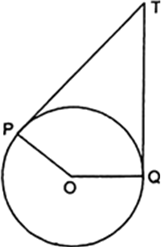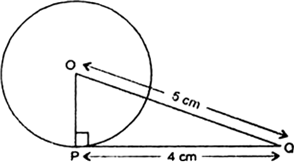 Fill In the Blanks
Fill In the Blanks Short Answer Type
Short Answer TypeA tangent PQ at a point P of a circle of radius 5 cm meets a line through the centre O at a point Q so that OQ = 12 cm. Length PQ is :  
(a) 12 cm    (b) 13 cm
(c) 8.5 cm    (d)  ![]()
From a point Q, the length of the tangent to a circle is 24 cm and the distance of Q from the centre is 25 cm. The radius of the circle is
(A) 7 cm      (B) 12 cm
(C) 15 cm    (D) 24.5 cm.
In Fig. 10.11, if TP and TQ are the two tangents to a circle with centre O so that ‚ą† POQ = 110¬į, then ‚ą† PTQ is equal to
(A) 60¬į ¬†¬†¬†(B) 70¬į
(C) 80¬į ¬†¬†¬†(D) 90¬į
Fig. 10.11
 Long Answer Type
Long Answer TypeIf tangents PA and PB from a point P to a circle with centre O are inclined to each other at angle of 80¬į, then ‚ą† POA is equal to
(A) 50¬į ¬†¬†¬†(B) 60¬į
(C) 70¬į ¬†¬†¬†(D) 80¬į.
 Short Answer Type
Short Answer TypeProve that the perpendicular at the point of contact to the tangent to a circle passes through the centre.
Since, the tangent at any point of a circle is perpendicular to radius through the point of contact.
Therefore, ‚ą†OPQ = 90¬į
It is given that OQ = 5 cm
and    PQ = 4 cm
In right őĒOPQ, we have
OQ2 = OP2 + PQ2
[Using Pythagoras Theorem]
OP2¬†= OQ2¬†‚Äď PQ2
‚áí OP2¬†= (5)2¬†‚Äď (4)2
= 25 ‚Äď 16 = 9
‚áí OP = 3 cm
Hence, the radius of the circle is 3 cm.
 Long Answer Type
Long Answer TypeTwo concentric circles are of radii 5 cm and 3 cm. Find the length of the chord of the larger circle which touches the smaller circle.
